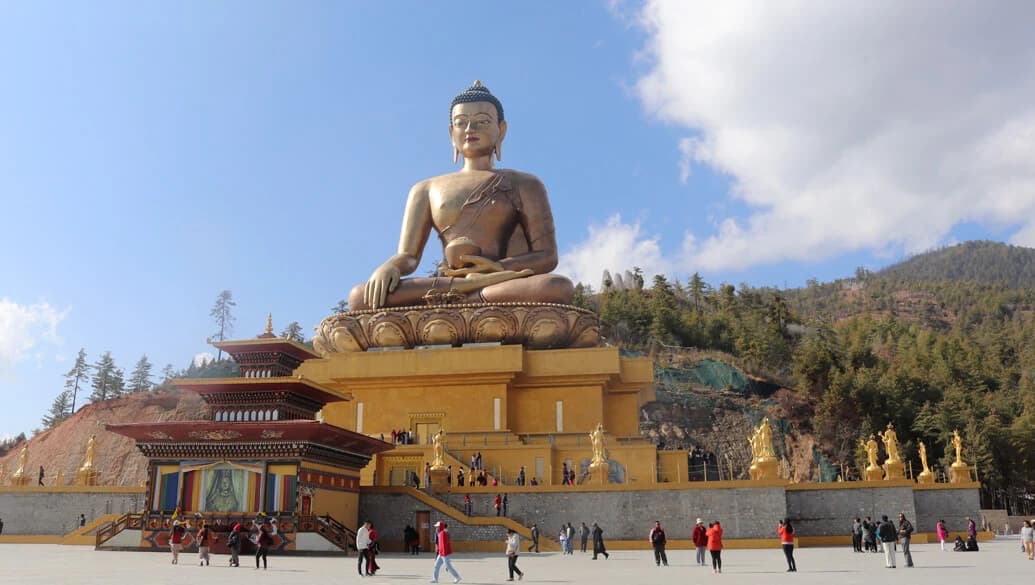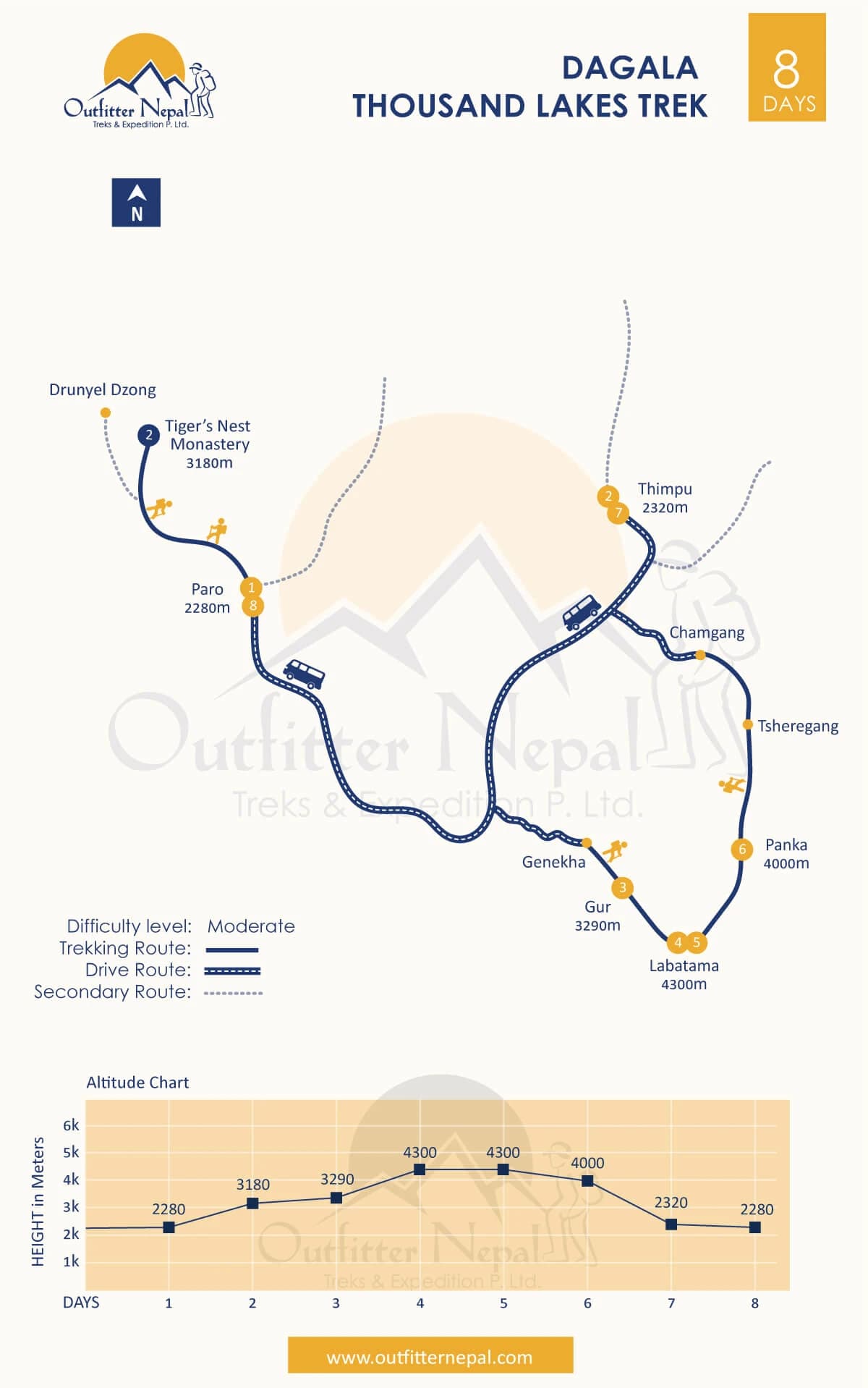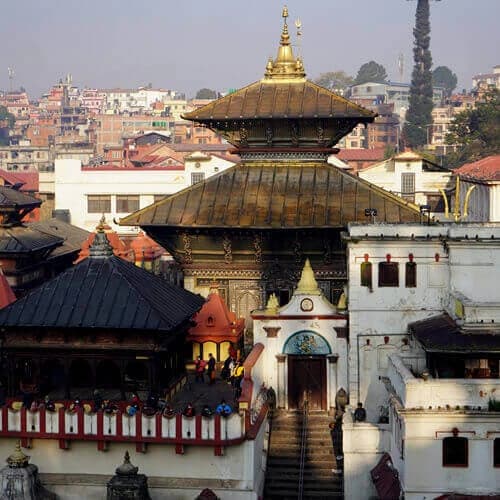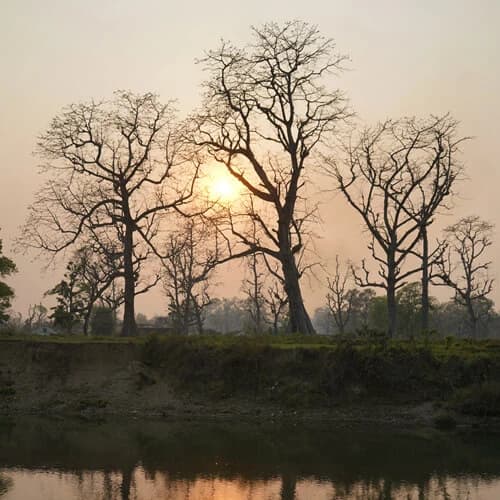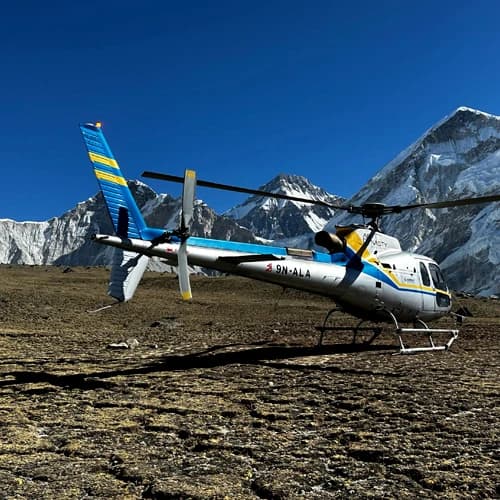Trek highlight of Dagala Thousand Lakes Trek
- Trek through numerous beautiful, high-altitude lakes like Relitsho, Jagetsho, and Setsho.
- Stunning panoramic views of peaks like Kanchenjunga, Jomolhari, and Masang Gang.
- Cross high-altitude passes including Dangala Pass (4,240m) and (4,350m).
- Spot exotic plantlife and wild animals, including blue Sheep, Bharal, Himalayan Ghoral, and Green Magpie.
- Immerse yourself in authentic Bhutanese culture and tradition.
- It is a spiritual landmark along the trail, providing a perfect setting for meditation and mindfulness.
Why it’s known as the Thousand Lakes Trek
The Thousand Lakes Trek in Bhutan is named after the numerous lakes along the trail. These serene water bodies are scattered throughout the beautiful Bhutanese landscape. The trek takes you through dense forests and pristine meadows. The lakes are located in sacred or protected areas, adding mysticism and spirituality to the journey. These lakes are considered to be holy sites by the locals. Thousands of travelers and religious followers visit the region to experience a deep connection with themselves and the divine. As a result, this aspect of the journey contributes to the cultural significance of the trek.
The Dagala Thousand Lakes trek is known for its peaceful and serene atmosphere, far from the usual tourist crowds, offering an intimate and spiritual experience. The 8-day trek package spans around 8 days, offering adventurers the chance to explore a remote, unspoiled region of the country. The trail passes through lush forests, meadows, and high-altitude landscapes, providing a tranquil escape into nature. One of the trek's highlights is the collection of pristine, crystal-clear lakes scattered throughout the region. Snow-capped peaks and vibrant plants and wildflowers surround these lakes.
During this remarkable journey, you will travel through traditional Bhutanese villages to experience the local culture, tradition, and hospitality. The trek requires a reasonable fitness level due to its elevation and the challenging terrain. Still, it rewards trekkers with unparalleled accomplishment and a deep connection to nature. It's considered one of Bhutan's most rewarding and less-traveled trekking routes, making it ideal for those seeking adventure, solitude, and a chance to experience Bhutan's untouched beauty.
Trek through Scenic High-Altitude Lakes
The Thousand Lakes Trek in Bhutan is a breathtaking high-altitude adventure that starts in the picturesque Bumthang Valley. The trail traverses through dense rhododendron, pine, and juniper forests, offering spectacular views of majestic peaks. This 8 Days trek takes adventurers to altitudes ranging from 2,600 to over 4,500 meters. You will pass by numerous lakes that glisten against the backdrop of towering mountains, which provide reflections that create a mesmerizing sight to behold. These lakes are dotted throughout the landscape, providing perfect photo opportunities. The Thousand Lakes Trek offers a rare and off-the-beaten-path experience in the heart of Bhutan's Himalayas, combining natural beauty, spiritual significance, and rich cultural heritage into one unforgettable journey.
Cultural significance of the journey
The Dagala Thousand Lakes Trek holds significant cultural value in Bhutan. It intertwines the landscape's natural beauty with the country's rich spiritual heritage. Bhutan is deeply rooted in Buddhism, and many of the lakes along the trek are considered sacred by locals. These lakes are often seen as places of spiritual reflection and offerings, and trekkers may come across prayer flags, stupas, and small monasteries, adding a profound cultural layer to the experience. The trek takes you through remote areas where Buddhist traditions and rituals are still integral to daily life. Such encounters provide insight into Bhutan's traditional way of life. Passing through villages and remote hamlets, trekkers can witness how the people live harmoniously with nature, maintaining a simple, self-sustained lifestyle that has remained unchanged for centuries. The community practices are rooted in a deep respect for nature, often shaped by Buddhist philosophies of mindfulness, reverence for life, and the environment. So, this remarkable journey offers an adventure in nature and a chance to connect with Bhutan's unique cultural and spiritual heritage.
Trekking permit for Thousand Lake Trek
The Dagala Thousand Lakes Trek in Bhutan is a stunning and challenging route that requires permits from authorized government bodies. To begin this trek, all visitors must go through a licensed Bhutanese tour operator, as independent trekking is not allowed. Your tour operator will make all the necessary arrangements in advance, including a guide and support team. This ensures a safe and well-managed travel experience in the magnificent lands of Bhutan.
Complete Guide to Bhutan Visa Requirement and Process
Travelers will need a valid Visa to enter Bhutan, except for citizens from India, Bangladesh, and the Maldives. Citizens from these nations will instead require a separate permit from the Department of Immigration. To obtain the license, the respective nationals should provide a copy of their passport, passport-size photos, an invitation from the Bhutanese host, and travel insurance. You can apply for the permit online, or your tour operator will provide it on your behalf. Remember that although you might be exempt from the Visa requirements, you will still need to pay SDF fees, which cost around 15 USD daily. On the other hand, travelers from other countries will require a tourist Visa to enter Bhutan. Provide the necessary documents to your copy of their passport, passport-size photos, flight ticket, and travel insurance to your tour operator. Please provide them 15 to 30 days before the departure date for a smooth and hassle-free operation. The visa application fee is 40 USD per person.
Additionally, travelers must pay the Sustainable Development Fee (SDF) of 100 USD per day. Children between the ages of 6 and 12 are charged 50 USD per day. Infants below the age of 5 are not eligible for any SDF fees. The SDF or Sustainable Development Fee initiative aims to protect Bhutan's culture and environment and revitalize its tourism sector.
Flight Information to Bhutan
The country has only one international airport located at Paro. Only a few airlines operate direct flights to Bhutan due to the country's strict regulations on air travel. The primary carriers that offer international flights to Bhutan are Druk Air and Bhutan Airlines. These two airlines mainly operate flights to Bhutan from key Asian cities, including Delhi, Kolkata, Kathmandu, Bangkok, and Singapore. Visitors can reach Bhutan from other major international hubs by connecting through one of these cities near your country of departure. We advise you to book your flights in advance due to the high number of reservations and limited flights to Bhutan during peak season. On the other hand, you can book the ticket through us for a seamless and hassle-free travel experience. So, you must provide the details you need to your tour operator for a smooth and seamless journey.
How to Book this Trek
To book the Dagala Thousand Lakes Trek, you must go through a licensed tour operator or an official agency. A 10% deposit of the total package cost is required to secure your booking. Don't hesitate to contact our representatives via email or WhatsApp to reserve your seat on the 8-day Dagala Thousand Lakes Trek. We will make all necessary arrangements, including your visa, permits, accommodations, and logistics. If you have any questions about the itinerary, pricing, duration, requirements, or documentation, feel free to reach out to us anytime. Our team is available 24/7 to assist you.
Cost of the Dagala Thousand Lakes Trek for 2025, 2026
The cost of the Dagala Thousand Lakes Trek ranges from USD to USD per person for the 2025, 2026 season. The price of the trek package varies depending on the tour operator, group size, and included services. It is important to note that the cost does not include international airfare, personal expenses, travel insurance, and tips. It's advisable to contact us directly for the most current pricing and detailed inclusions.
